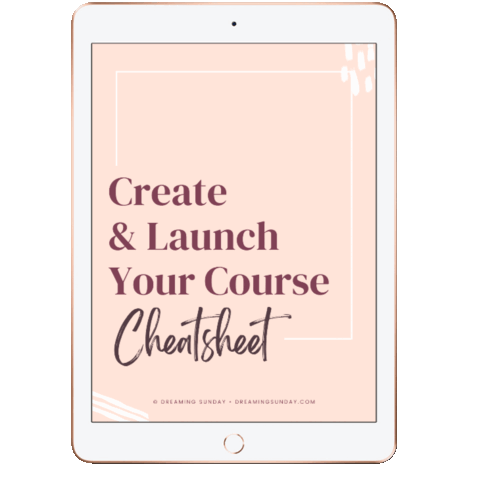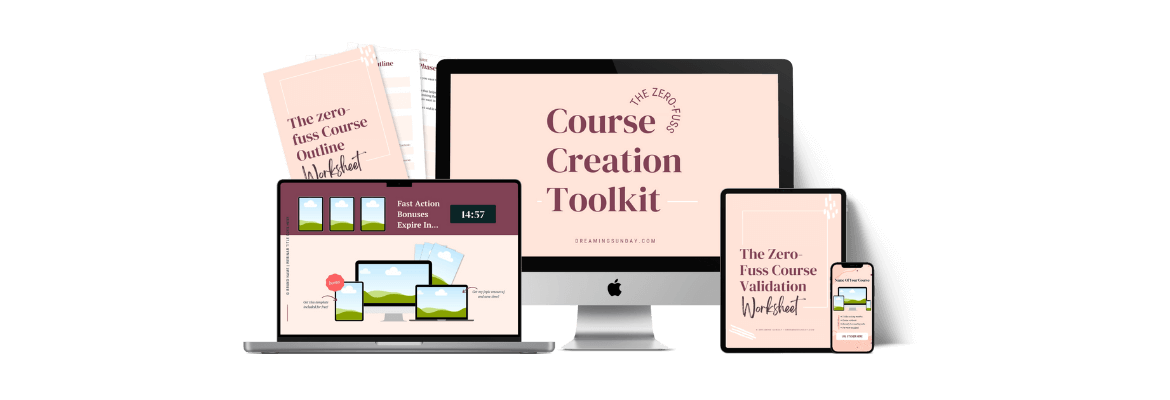If you’re a course creator ready to launch your course, you may be thinking that you need a HUGE email list to have a profitable launch (been there, done that). But, I’m here to show you why that’s not the case and which numbers will really affect your launch.

I’ve spent the last 5 years working for 7-figure entrepreneurs and helping them with their 6-figure course launches (promise I’ll stop saying numbers soon).
I’ve also spent a large part of that time supporting and coaching smaller creators to launch their first or next offers to tiny audiences.
I’ve seen what it makes a launch a hit or a flop and it’s not always the size of your list.
And almost always, things boil down to this one question:
Do you really need thousands of subscribers to hit your revenue goals?
Most people in our industry believe that and put all their efforts into growing massive email lists, spending unholy amounts of money into ads and doing everything they can to attract more people.
The bigger your list, the bigger the launch results. Right?
What if that wasn’t the case? What if you could be wildly successful without needing Taylor Swift Eras Tour audience levels to reach your goals?

Let me ask you another question. If I could wave my magic wand and make one of these two scenarios for you possible, what would you pick?
(Don’t reach for your calculator just yet, go with the intuitive answer.)
If you said the first option, you’d be among the majority of people and you likely believe your success depends on the size of your email list.
However, if you chose the second option, you’re onto something here 😉
2% of 10K is 200 sales, which is amazing. But 5% of 5K is 250 sales. What?!
So is putting all your effort into growing a huge email list, adding thousands of contacts to your list every launch really the end all be all?

Free guide
Go from course idea to launch with this step by step roadmap
What metrics should you focus on to have a successful course launch with a small list?
Okay, so what are some numbers you really need to focus on so you can make your launch a hit without the stress of finding thousands of people every single time?
1. Your landing page conversion rate
Imagine pouring water into a leaky bucket. That’s your landing page if you focus on sending thousands of people to it without optimizing it first and making sure it converts.
Landing pages can convert better than pumpkin spice lattes in September if you do it right. Imagine converting 50-70% of all the visitors it gets?
It is possible!
In my most recent launch with a client, the free challenge landing page I designed converted at 55% even with cold traffic (aka people who had never heard of us before). It converted even better at 75% for our existing subscribers.
(Btw, this client wasn’t in a make money online or weight loss niche.)
When you’re paying for ads, every click to your landing page counts, so you want to have a page that’s optimized to turn them into a subscriber.
How do you calculate your landing page conversion rates?
An easy way to calculate it is by dividing the subscribers you got form a specific lead magnet by the number of visitors the landing page received and then multiplying it by 100.
If you got 314 subscribers and the page got 1000 visitors:
(314/1000)*100 = 31.4% conversion rate
Not bad! But it could be way higher and you could be getting many more subscribers with the same traffic!
Now, it’s important that you don’t get the wrong expectations. You won’t normally see such high conversion rates on your regular opt-in forms on your site. Those generally convert at 2-5%.
A landing page is specifically built to get someone to opt-in, it has zero distractions, a juicy free offer and an easy way to sign up.
Conversions are higher on landing pages than on individual opt-in forms. That said, aim to get your landing page to convert at around 40% or higher.

Free guide
Go from course idea to launch with this step by step roadmap
2. Your clickthrough rates
Now, you may have noticed I didn’t specify what clickthrough rates (CTR). And that’s on purpose 😉
Clickthrough rates are the number of people that click on a link out of all the people that saw/received it. So it could be the clickthrough rate on your emails pointing to your sales page, or from your webinar to your sales page, etc.
If you’re a new course creator, perhaps you’re not feeling confident in launching with webinars. That’s okay! In that case, you want to keep an eye on your email click through rates.
Each time you send a sales email, check your CTR. Are people clicking on the links to your sales page? You want your CTR to be over 1%, but preferably higher if you have a small list.
If your CTR is lower than 1%, here are some tips to increase it:
If your CTR is lower than 1%, here are some tips to increase it:
A low CTR might also mean people aren’t enticed by your copy or the offer itself, so if you have low CTR you will need to investigate and test things to up it.
Getting people to buy without visiting the sales page is impossible, so your focus should be on getting the click.
If you’re using webinars, during the webinar your main job is to get attendees to click through to the sales page to enroll in your course while you’re live (and snag some bonuses in the process).

3. Your sales PAGE conversion rate
Similarly, how many of the people who visits your sales page end up buying? In the previous section you focused on getting the click to the sales page, now it’s your sales page’s job to get the sale.
The more subscribers you have, the more sales you’ll make (normally). But if you focus on upping your conversion rates from the average 2% you’ll be able to make more sales and impact more people.
Want to do that? It’s easier than you think.
Nurture your existing audience. Send them valuable emails, freebies, workshops, anything you can think of to make them know, like and trust you.
When you show up in their life regularly and make it better, they’ll trust you with their money to continue teaching and guiding them.
Consistency is key! Think of who you’ve bought programs and products from. Why did you trust them? How long were you in their orbit before you gave them a single cent?
You wouldn’t give someone your money if they showed up once and then fell off the face of the earth for months only to resurface for a quick moment only to vanish again. Right?
You want to be a consistent source of support and encouragement for your audience, always there for them come hail or high water. Then they’ll be ready to tell you to shut up and take their money.
How do you calculate your sales page conversion rates?
An easy way to calculate it is by dividing the users that bought your course by the number of visitors the sales page received and then multiplying it by 100.
If you got 33 sales and the page was viewed by 1000 users:
(33/1000)*100 = 3.3% conversion rate
That’s great! Keep nurturing your audience and supporting them and you’ll see the number of students enrolling in your course grow with each launch.
✦ Remember: Whether people buy from you in your next launch or not will depend on the support you give them when you’re not launching.

Free guide
Go from course idea to launch with this step by step roadmap
Over to you — Which launch metrics are you going to focus on optimizing next?
Now you know that launches aren’t all about having a big email list and that you can hit your revenue goals even if you have a small audience. Yay!
But you also know that certain numbers can move the needle forward and have a big impact in your bottom line more than others. Like your landing page conversion rates, click through rates and sales conversion rates.
Leave a comment below and let me know which of these do you need to fix next to get better results from your launches and drive more sales without spending thousands on ads?
Stay tuned, I’ll be sharing more tips to optimize your landing pages soon!
Until then, want to create your course without spending weeks or months on it?
My Course Creation Toolkit takes the guesswork and the hard work out of creating a course. Get instant access to course lesson templates, webinar templates, social media graphics, course creation guides, launch plans, and more.

Quickly create your online course with customizable, done-for-you templates and workbooks.
